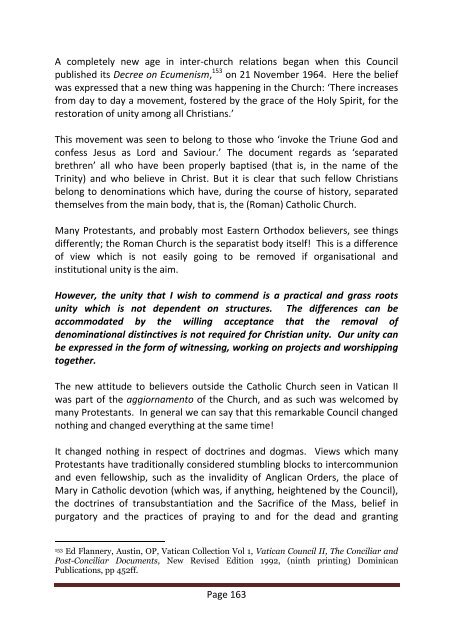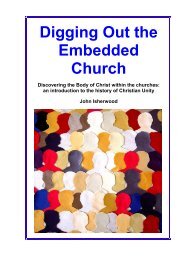Christian Unity (the book) - The Maranatha Community
Christian Unity (the book) - The Maranatha Community
Christian Unity (the book) - The Maranatha Community
You also want an ePaper? Increase the reach of your titles
YUMPU automatically turns print PDFs into web optimized ePapers that Google loves.
A completely new age in inter-church relations began when this Councilpublished its Decree on Ecumenism, 153 on 21 November 1964. Here <strong>the</strong> beliefwas expressed that a new thing was happening in <strong>the</strong> Church: ‘<strong>The</strong>re increasesfrom day to day a movement, fostered by <strong>the</strong> grace of <strong>the</strong> Holy Spirit, for <strong>the</strong>restoration of unity among all <strong>Christian</strong>s.’This movement was seen to belong to those who ‘invoke <strong>the</strong> Triune God andconfess Jesus as Lord and Saviour.’ <strong>The</strong> document regards as ‘separatedbrethren’ all who have been properly baptised (that is, in <strong>the</strong> name of <strong>the</strong>Trinity) and who believe in Christ. But it is clear that such fellow <strong>Christian</strong>sbelong to denominations which have, during <strong>the</strong> course of history, separated<strong>the</strong>mselves from <strong>the</strong> main body, that is, <strong>the</strong> (Roman) Catholic Church.Many Protestants, and probably most Eastern Orthodox believers, see thingsdifferently; <strong>the</strong> Roman Church is <strong>the</strong> separatist body itself! This is a differenceof view which is not easily going to be removed if organisational andinstitutional unity is <strong>the</strong> aim.However, <strong>the</strong> unity that I wish to commend is a practical and grass rootsunity which is not dependent on structures. <strong>The</strong> differences can beaccommodated by <strong>the</strong> willing acceptance that <strong>the</strong> removal ofdenominational distinctives is not required for <strong>Christian</strong> unity. Our unity canbe expressed in <strong>the</strong> form of witnessing, working on projects and worshippingtoge<strong>the</strong>r.<strong>The</strong> new attitude to believers outside <strong>the</strong> Catholic Church seen in Vatican IIwas part of <strong>the</strong> aggiornamento of <strong>the</strong> Church, and as such was welcomed bymany Protestants. In general we can say that this remarkable Council changednothing and changed everything at <strong>the</strong> same time!It changed nothing in respect of doctrines and dogmas. Views which manyProtestants have traditionally considered stumbling blocks to intercommunionand even fellowship, such as <strong>the</strong> invalidity of Anglican Orders, <strong>the</strong> place ofMary in Catholic devotion (which was, if anything, heightened by <strong>the</strong> Council),<strong>the</strong> doctrines of transubstantiation and <strong>the</strong> Sacrifice of <strong>the</strong> Mass, belief inpurgatory and <strong>the</strong> practices of praying to and for <strong>the</strong> dead and granting153Ed Flannery, Austin, OP, Vatican Collection Vol 1, Vatican Council II, <strong>The</strong> Conciliar andPost-Conciliar Documents, New Revised Edition 1992, (ninth printing) DominicanPublications, pp 452ff.Page 163








